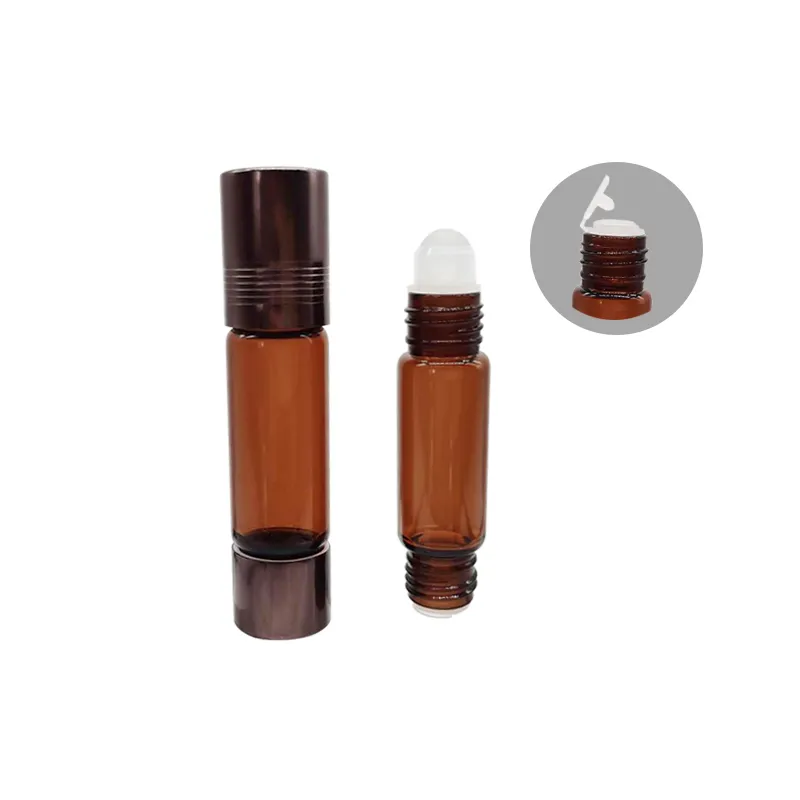Multifunctional Laboratory Applications of Double Ended Vials
✒️ Introduction
Double ended vials are specially designed laboratory containers with openings at both ends, usually equipped with removable sealing caps or spacers. This configuration allows the user to load or remove samples from either section, increasing operational flexibility and convenience. Double ended vials are usually made of high purity glass or chemically resistant plastics and are suitable for storing, transporting and handling all types of liquid or solid samples.
Efficient and safe sample management is essential in modern laboratories. Double ended vials are widely used in pharmaceutical, biochemical, environmental monitoring and clinical research due to their unique double opening design.They not only simplify automated high-throughput experimental processes, but also reduce the risk of cross-contamination, making them ideal for many precision experiments.
The purpose of this paper is to analyze the versatility of Double-Ended Vials, explore their advantages in different experimental scenarios, and evaluate their improvements over traditional single-ended containers for laboratory workers.
✒️ Structure and Characteristics of Double-ended Vials
1. Physical structure
The design of the double-ended vials allows for a high degree of flexibility in laboratory operations, and the main structural features include:
Double-opening design: both ends can be opened for easy loading and removing of samples, which is suitable for different experimental process needs.
Common Materials
-
- Glass: such as borosilicate glass, high temperature and chemical resistant, suitable for HPLC, GC and other analytical experiments.
- Plastic: e.g. polypropylene, PEEK, lightweight and impact resistant, suitable for biological sample storage or disposable experiments.
Diversified specifications: wide range of capacity, usually 1ml-20ml; various sealing methods, including screw cap, gland, spacer sealing, to ensure the stability of samples.
2. Core strengths
Double-ended vials offer the following significant advantages in laboratory applications:
Convenient sample access: Both ends can be operated, reducing the risk of contamination by repeatedly opening and closing the same port, especially for sterile or highly sensitive experiments.
Compatible with automated systems: Suitable for high throughput experiments (e.g. drug screening, genomics), increasing the efficiency of experiments. It is also compatible with autosamplers and liquid handling robots to minimize manual intervention.
Wide range of compatibility: Different sealing methods (e.g. PTFE/silicone gaskets) are available to meet the needs of inert gas protection for volatile samples. Suitable for a variety of experimental scenarios, such as chromatography analysis, low temperature storage, chemical reactions, etc.
With its unique structure and versatility, the double-ended bottle has become an indispensable tool for the modern laboratory.
✒️ The Main Applications of Double-ended Vials in the Laboratory
1. Sample storage and transfer
Efficient storage capacity: suitable for long-term or short-term preservation of liquid, solid and semi-solid samples, ensuring sample stability.
Chromatography (HPLC, GC): widely yo about sample vials for High Performance Liquid Chromatography (HPLC) and Gas Chromatography (GC) to reduce residue and cross-contamination. Double-end design facilitates direct sampling by autosampler and improves analytical efficiency.
2. High-throughput screening and automated experiments
Robotic pipetting system compatibility: can be seamlessly connected with automated liquid handling workstations to enhance experimental throughput.
Reduced manual errors: the double-ended design optimizes sample access and reduces the risk of errors caused by human intervention.
Suitable for 96-well or 384-well plate system: Manu large-scale drug screening, genomics and other research needs.
3. Specialized experimental environmental requirements
Inert gas protection test: for anhydrous and oxygen-free reactions (e.g., organometallic chemistry, storage of air-sensitive chemicals). It can be sealed with a gasket to realize repeated vacuum-filling and inert gas operation.
Applications under extreme temperature conditions
-
- Low temperature storage: e.g. freezing at -80°C, liquid nitrogen environment still maintains good sealing.
- High-temperature reactions: e.g. catalytic reactions, thermal cracking experiments, high-temperature-resistant glass ensures safety.
4. Pharmaceutical and biotechnology
Drug R&D and quality control: for stability testing of APIs, intermediates and preparations, in compliance with GMP standards, to ensure sample traceability.
Biological experiment application
-
- Cell culture: store culture media and cell suspensions to reduce the risk of contamination.
- Gene sequencing and PCR: as a sample storage container for high throughput sequencing (NGS) or qPCR.
- Protein purification and crystallization: suitable for dispensing and storing micro samples.
With their versatility, double-ended vials play a key role in several fields of research and industry, becoming an important tool for improving the efficiency of experiments and the reliability of data.
✒️ Comparative Analysis of Double-ended Bottles and Conventional Containers
1. Performance comparison with conventional single-ended bottles
Double-ended bottles show significant advantages in terms of ease of operation. The unique double-ended opening design allows the lab technician to access the sample directly from either end, completely eliminating the need for pouring or pipetting with traditional single-ended bottles. This design not only simplifies the experimental procedure, but more importantly significantly reduces the risk of contamination due to repeated opening and closing of the same port, which is particularly important for sterility or high sensitivity experiments.
In terms of automation compatibility, double-ended bottles are more suitable for autosampling systems, effectively improving experimental throughput; traditional single-ended bottles are less compatible with some automation equipment. In addition, the double-ended design can effectively reduce the sample residue and improve the recovery rate of precious samples, while traditional single-ended bottles often cause unnecessary losses due to problems such as sample hanging on the wall.
2. Differentiation from other commonly used laboratory packagings
Compared with common laboratory centrifuge tubes, double-ended bottles are superior in sealing performance. Its precise sealing system is especially suitable for storing volatile samples or precious samples that need to be kept for a long time. While centrifuge tubes excel in high-speed centrifugation scenarios, double-ended vials are often a more specialized choice for applications that require a high degree of sealing, such as chromatography.
Compared to micro PCR tubes, double-ended vials offer a wider range of volume options (typically 1ml-20ml) and are able to meet more diverse experimental needs. At the same time, they are more tolerant of temperature extremes, allowing them to be used for both high-temperature reactions and ultra-low-temperature storage tasks. PCR tubes, on the other hand, are relatively limited in application due to capacity constraints.
In terms of biological sample storage, double-ended vials show better flexibility than specialized cryopreservation tubes. The double-ended design not only facilitates labeling and access, but is also more compatible with automated sample management systems. Although cryopreservation tubes have their own specialized advantages in cell storage, dual-ended vials often provide higher work efficiency in scenarios that require frequent access or automated processing.
Comprehensive value assessment
Comparative analysis reveals that the double-ended vials have obvious advantages in terms of ease of experimental operation, reliability of sample protection, and automation compatibility. Although the unit cost may be slightly higher than some traditional containers, these specialized containers tend to bring higher overall value from the perspective of improving experimental efficiency, ensuring data reliability and reducing overall experimental risk. Especially in precision analysis, high-throughput screening and special environmental experiments and other high-end application scenarios, the professional performance advantages of double-ended vials make them an irreplaceable choice of experimental tools.
✒️ Future Development Trends and Innovative Directions
1. Breakthroughs in materials science
In terms of material improvements, the new generation of double-ended bottles is moving towards higher performance. Researchers are developing glass materials with special coatings that not only provide greater chemical inertness, but also effectively reduce sample adsorption, making them particularly suitable for trace analysis and ultra-pure sample storage.
Environmentally friendly biodegradable materials are another important development direction. As the concept of sustainability in the laboratory becomes more widespread, double-ended bottles made from bio-based polymers or modified cellulose materials are emerging in the laboratory scene. These materials can be degraded under certain conditions while maintaining the necessary mechanical properties, significantly reducing laboratory plastic waste. Of particular note, certain new composites have been able to achieve chemical resistance comparable to conventional laboratory plastics while maintaining transparency.
2. Innovative applications in frontier science
In the field of nanotechnology, double-ended vials are being redesigned to suit specific needs. Miniaturized double-ended vessels (sodium upgraded capacity) coupled with precise fluid control systems provide an ideal platform for nanoparticle synthesis and characterization. These specially designed vessels often integrate magnetic stirring or temperature sensing to enable precise control of the nanomaterial preparation process.
The rise of microfluidic technology has opened up a new due diligence scenario for double-ended vials. By integrating a microfluidic chip with a double-ended vessel, researchers have developed a “smart” sample-handling system. This system utilizes a double-ended design to achieve a bi-directional controlled flow of fluids, showing unique advantages in cutting-edge fields such as single-cell analysis and organ microarrays.
A new generation of double-ended vials is breaking through the traditional limitations in extreme environment experiments. Vessels made of special alloy-reinforced glass or transparent ceramic materials are able to withstand higher working pressures and wider temperature ranges, providing reliable tools for special experiments such as supercritical fluid research and high-temperature catalysis.
✒️ Conclusion
With its innovative double-ended design concept, the double-ended vial has established an irreplaceable position in modern laboratory science. This seemingly simple structural innovation actually solves many of the pain points that have slowed down traditional sample containers in terms of operational processes, contamination control and automation compatibility. From basic sample storage to complex analytical testing, from routine laboratory operations to high-throughput automated processes, double-ended vials have demonstrated excellent adaptability and reliability. Its value is not only reflected in improving the efficiency of individual experimental processes, but more importantly, optimizing the workflow of the entire experimental system, providing a solid guarantee for the accuracy and reproducibility of scientific research data.
With the development of experimental science in the direction of more precision, automation and intelligence, the application prospect of double-ended vials will be even broader. We can foresee that it will continue to play an important role in the field of personalized medicine and precision diagnosis, automated laboratories and AI-driven experimental platforms, and some special scientific research scenarios.
It is foreseeable that double-ended vials will continue to evolve along with the innovation of experimental technology, and their core design concepts will provide continuous inspiration for the future development of laboratories. This combination of practicality and innovation will certainly play an even more important role in promoting scientific research progress.

 Italiano
Italiano Português
Português
